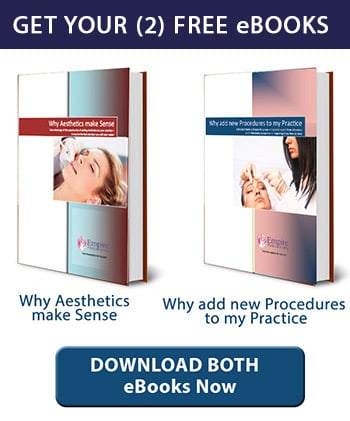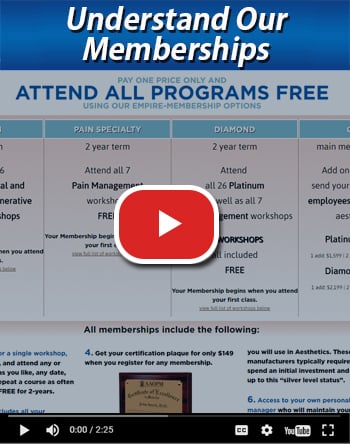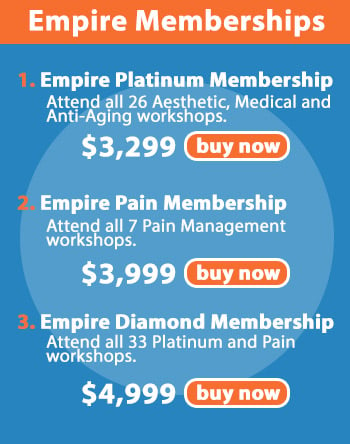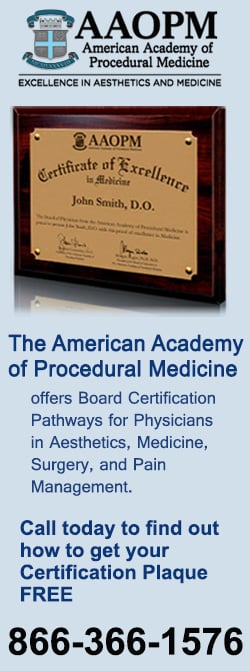Accreditation Information – PDO Thread Lift Training l
This activity is jointly provided by Medical Education Resources and Empire Medical Training.
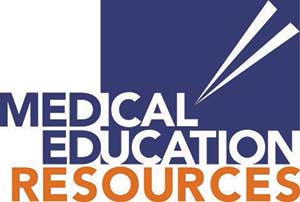
Title of Activity
PDO Thread Lift Training I
Date and Location
Please see individual dates from calendar above
Target Audience
This activity has been designed to meet the educational needs of Health Care Practitioners involved in the care of the patients with medical and aesthetic requests.
Program Overview
Present, understand and acquire the necessary skills to properly identify patients who will maximally benefit from implementing PDO Thread Lift procedures as a compliment to other aesthetic medicine approaches for enhance patient care, compliance, and improved outcomes for a variety of aging presentations by patients. Review current data on the safety and efficacy of PDO thread lift procedures, peer to peer cite review, standards of care, protocols, contraindications, exclusion criteria, as well as other possible patient presentations are provided to provide a context for patient perceptions and enhanced patient care.
Learning Outcome
To provide learners with a foundation for following correct standards of care and acquire the necessary technical skills to perform each of these procedures correctly and by adhering to published protocols and guidelines
Educational Objectives
- Practice and Perform and administer PDO Thread Lift procedures competently, safely, and effectively for their patient personalizing and tailoring these services to the individual patient, needs of the patient, and desired outcomes for the patient. Each participant will understand and learn how to avoid risks, pitfalls, complications, and adverse events to patients to increase overall care and patient results.
- Apply generally accepted protocols and latest literature concerning the selection, placement, and volume of PDO sutures for optimal results for patients. Learn the proper guidelines for the placement of PDO sutures for aesthetic patient indications for correction as well as administration issues (i.e. patient intake forms, informed consents) and the corrective measures for follow up including possible complications or adverse events associated with the procedure.
- Identify the mechanism of action of PDO sutures and basic facial anatomy, differences between the product characteristics and areas of injection, managing expectations, administration of the medical device and post treatment care for follow up after the PDO Thread Lift procedure.
- Assess who is a candidate for the PDO Thread Lift procedure, patient benefits, and anatomical areas that PDO sutures are acceptable for treatment. Increase patient awareness and offer enhanced patient care in relation to the PDO Thread Lift procedure and their desires aesthetically.
Faculty
Please see faculty page
Program Agenda
Agenda
Day 1
8:30am--9:00am
Registration9:00am--9:30am
Physician Introduction, Brief history and definition of PDO Thread Sutures including product characteristics, mechanism of action, potential uses, indications for treatment, and patient considerations.
9:30am--10:30am
Review the various types of PDO sutures commercially available and their potential use in various facial and body part areas. Differentiate the types of FDA Cleared threads in relation to dimensions, gauge, and length for the appropriate use in the application of PDO sutures medically and aesthetically. Advantages and disadvantages of using PDO Thread Lift sutures for correction compared to other conventional treatment options for the most common aesthetic conditions including “standard of care” considerations for enhanced patient care.10:30am—10:45am
Break
10:45am—11:15am
Combination or stand-alone treatments using the various types of threads including relative and absolute contraindications for treatment. Review guidelines for who is a “good candidate for treatment”, risks and possible complications, adverse events, limitations associated with the procedure, and setting patient expectations.11:15am – 12:15pm
Review of Facial anatomy in relation to vascular, muscular, and neural structures preceding the PDO Thread Lift training for depth, insertion, and placement. Evaluate and assess the aging process associated with patient presentation and planning considerations for the procedure. Final appraisal of the patient and selection of the various types of PDO Thread sutures – planning for the procedure. Review standard of care for “clean room” procedures, keeping a sterile field, and anesthesia options (considerations) for patients depending upon facial or body part area.12:15pm – 1:00pm
Lunch1:00pm – 1:30pm
Review generally accepted sample protocols for the placement of smooth (mono) PDO sutures for the correction of tissue density, tissue volume, or scaffolding of the tissue area creating a “mesh” effect. Placement considerations concerning number of threads, gauge of thread, and physical placement of threads are discussed for the common facial and body part areas including actual technique strategies that may be utilized to support tissue structures.1:30pm – 2:00pm
Live demonstration by Physician Instructor for placement of the Smooth (mono) PDO Thread Suture. Questions and Answers.2:00pm-- 5:00pm
Supervised Hands-On Training for attendees on volunteer patients utilizing Smooth (mono) PDO threads utilizing the various types of PDO (mono) sutures for a variety of facial and possible body indications (dependent on volunteer indications for treatment).
Physician Credit
This activity has been planned and implemented in accordance with the accreditation requirements and policies of the Accreditation Council for Continuing Medical Education (ACCME) through the joint providership of Medical Education Resources (MER) and Empire Medical Training, Inc. . MER is accredited by the ACCME to provide continuing medical education for physicians.
Credit Designation
Medical Education Resources designates this live activity, for a maximum of 7.00 AMA PRA Category 1 Credit(s)™. Physicians should claim only the credit commensurate with the extent of their participation in the activity.
Nursing Credit
Medical Education Resources is accredited as a provider of continuing nursing education by the American Nurses Credentialing Center’s Commission on Accreditation.
This CE activity provides 7.0 contact hours of continuing nursing education.
Medical Education Resources is a provider of continuing nursing education by the California Board of Registered Nursing, Provider #CEP 12299, for [7.00] contact hours.
Disclosure of Conflicts of Interest
It is the policy of Medical Education Resources to ensure balance, independence, objectivity, and scientific rigor in all of its educational activities. In accordance with this policy, MER identifies conflicts of interest with its instructors, content managers, and other individuals who are in a position to control the content of an activity. Conflicts are resolved by MER to ensure that all scientific research referred to, reported, or used in a continuing education activity conforms to the generally accepted standards of experimental design, data collection, and analysis.

